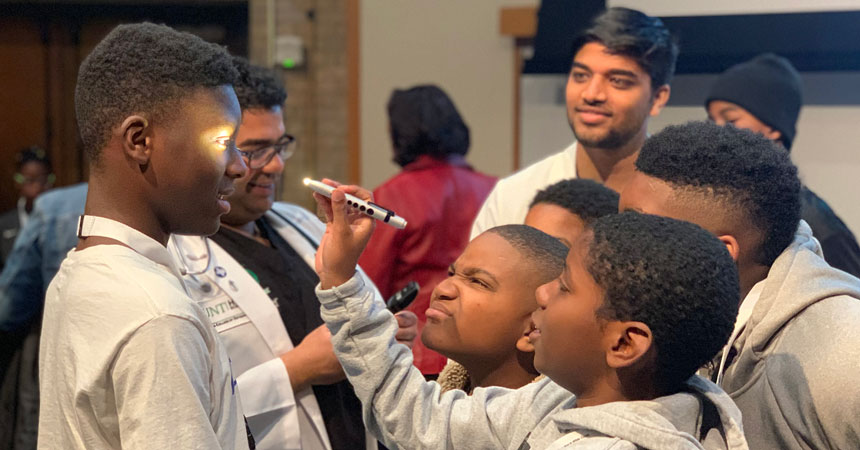TCOM students inspire youths to pursue medicine
By Alex Branch
More than 40 UNT Health Science Center medical students helped inspire young African-American males to consider careers in medicine at a youth summit in Dallas.
The students, members of the Texas College of Osteopathic Medicine Student National Medical Association (SNMA) chapter, showed more than 300 children in grades 3 through 8 how to listen to heartbeats and lungs, and check pulses and reflexes.
HSC InsiderLearn more about UNTHSC’s people and programs by signing up for the weekly HSC Insider email. |
The summit was a collaboration with Black Men in White Coats, an organization devoted to increasing the number of black men in medicine through exposure, inspiration and mentorship. The event was held at UT Southwestern Medical Center.
African-American men make up 6 percent of the country’s population, but they were less than 2 percent of the nation’s 18,000 medical school students, according to a 2015 report from the American Association of Medical Colleges
“It was a great experience because there were African-American physicians from not only North Texas but Georgia and Florida,” said Carly Randall, a TCOM student and SNMA president. “These kids don’t usually see many doctors who look like them. It’s so important for them to see that medicine is a viable path to pursue.”
Black Men in White Coats was founded by Dale Okorodudu, Assistant Professor of Internal Medicine at UT Southwestern.
Youth summit attendees included many parents and community leaders, he said. Several parents asked students how they could support their children’s interest in medicine.
“Seeing so many young students from diverse backgrounds being supported by parents, teachers, and mentors gave me a greater hope,” Dr. Okorodudu said. “We’re on a mission to inspire and mentor the youth.”
The youth summit perfectly fit the student organization’s mission, said Jennifer Archer, SNMA vice president. Student members work to support current and future underrepresented minority medical students, address the needs of underserved communities, and increase the number of clinically excellent, culturally competent and socially conscious physicians.
“We talked to the kids about what doctors do and why medicine is important and gave away prizes from the Health Science Center,” Archer said. “Hearing the kids say how cool it was really warmed our hearts.”







Social media